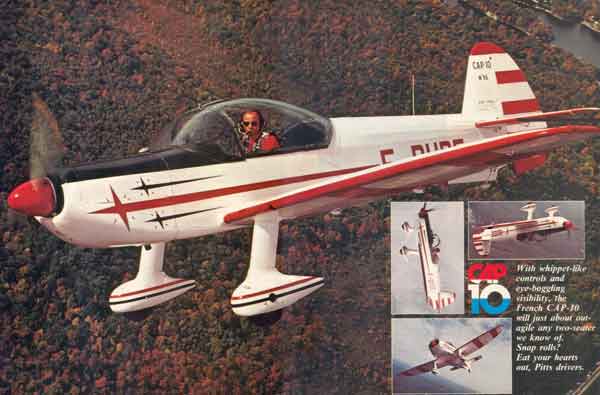
 |
PAGE TWO Rather than running up the Hudson, jumping into a CAP, thrashing around for an hour and then dashing back to our respective typewriters (what’s a “typewriter?”), we thought we'd try a little different approach. "We" being Dave "Iron Guts" Noland and me, the Chicken Little of New Jersey. Actually, it was Noland who suggested we do the CAP 10 pirep thing as a team, my being the instructor and his being the student. As a matter of fact, it wasn't exactly a suggestion. It was something more akin to a direct order backed up by threats of great bodily damage if I didn't give him a chance to fly the airplane, too. Editors seem to have this thing about contributors having all the fun. So we flew something in the neighborhood of six or seven hours between us, some of it checkout, the rest a super cram course on how to re-dimple your navel in four "easy" lessons. Avions Mudry of Poughkeepsie consists of Daniel Heligoin (say it "eligwa" and you'll make points) and Montaine Moullet (she's tired of being called Mallet, as in hammer). Daniel was national champion of France two years running, and his flying and instruction shows it. Montaine is a delightfully bouncy little thing who also happens to be an aeronautical engineer. Fem libbers take note. It was through the accent-sprinkled conversations of these two that we came to know the CAP 10.
It may be the engineer in me or my natural cynicism coming to the surface, but I like to poke and prod an airplane before I get up and try to twist its tail oft. So rather than going through the usual follow-me-during the-preflight airframe inspection, I looked and touched while Montaine filled me in on what was under the CAP's dacron covering. One of the biggest surprises to me, being part of the chromoly generation, was that the CAP's fuselage is a wooden truss structure. That means it's a bridge like affair of roughly one-inch square members joined at their ends by gussets and shear plates. My surprise was not because the structure was in any way inadequate, it's just that you don't see that type of thing much anymore. It's too expensive. In some ways it's superior to sheet metal because wood doesn't have the usual fatigue problems of aluminum and modern sealers and glues have solved the joint and rot problems. Still, it's time-consuming. The wing is also wood, but is uses the more familiar spar/rib/plywood covering routine that has made Bellanca's Viking such a winner. The airfoil, for you airfoil freaks, is a NACA 23012, which means it's not quite symmetrical but keeps good company since it was used on such things as Bearcats, Swifts, and more recently, Leo Loudenslager's winning Stephens Akro. Probably the biggest reason the 23000 series airfoils have lost out to the modern laminar flow wings on many U.S. designs is it has a sharpish stall, which is a no-no now. Of course, for good aerobatics you want a stall that breaks cleanly. And on a trainer, a pronounced stall gives the student a better feeling for what's happening, rather than these new-fangled jobs that just fuss while the rate of sink skyrockets. The fuel injected Lycoming 180 hides under a fiberglass cowl and spins a wooden, 'glass covered prop, something I didn't notice for a couple hours because it's painted silver and looks like aluminum. The inverted fuel system uses the standard flop tube arrangement in the main tank and as we were there flying the airplane, word came that Mudry had just certified the Christen full inverted oil system for the CAPs. The airplanes we were flying had only 30-45 seconds of inverted oil pickup, but the Christen system will let you hang from your seat belt until your hair falls out. The 36 gallons of gas are held in two wing tanks and a fuselage tank that's sandwiched between the instrument panel and the firewall. The wing tanks are supposed to be empty for aerobatics. |
||